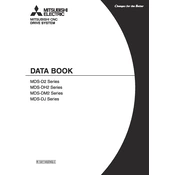Mitsubishi Electric CNC MDS D2, MDS DH2 Series Users Manual


To perform a basic startup operation, first ensure all connections are secure. Power on the main switch, check for any alarm indications on the display, and reset any alarms. Verify that the machine is in the correct mode for operation and perform a test run without load to ensure all systems are functioning properly.
If an overcurrent alarm is displayed, first check for any short circuits or grounding issues in the motor connections. Inspect the load conditions and reduce if necessary. Ensure that the parameters for current limits are set correctly in the controller. If the issue persists, consult the manual for the specific alarm code or contact technical support.
To optimize performance, regularly update the software and ensure all components are clean and lubricated. Adjust the servo parameters for speed and torque to match the specific needs of your application. Regularly calibrate the machine and monitor for any deviations in performance.
Regularly inspect the spindle motor for any signs of wear or damage. Clean the motor and surrounding areas to prevent dust accumulation. Lubricate the bearings as per the manufacturer’s instructions and check the alignment regularly. Perform a vibration analysis periodically to detect any potential issues early.
Check all communication cable connections between the CNC controller and the drive unit. Ensure that all cables are intact without any visible damage. Verify the communication settings and parameters in the CNC control software. If the issue persists, replace the communication cables or consult the technical manual for further diagnostics.
To reset a servo alarm, first identify the cause of the alarm using the alarm code displayed. Ensure that the machine is in a safe state and the issue is resolved. Press the alarm reset button or use the control panel interface to reset the alarm. If the alarm does not clear, investigate further using the troubleshooting guide.
Regularly calibrate the machine using precision calibration tools. Check and adjust the backlash compensation settings in the CNC controller. Ensure that the machine is level and the tool holders are free from debris. Use high-precision tooling and regularly inspect the tool offsets.
During a routine check-up, inspect all electrical connections for tightness and signs of wear. Check the cooling system for proper operation and clean any filters. Inspect mechanical components for any signs of wear or misalignment. Verify all safety systems are functioning correctly and update software if necessary.
To update the firmware, first obtain the latest firmware version from the manufacturer's website. Follow the instructions provided with the firmware for preparing the update media. Insert the update media into the CNC controller and follow the on-screen instructions to complete the update process. Ensure the machine remains powered during the update.
Ensure the machine is powered off and locked out before beginning any servicing. Use appropriate personal protective equipment (PPE) such as gloves and safety glasses. Follow all safety instructions provided in the service manual, and be aware of any moving parts. If in doubt, consult a professional technician.